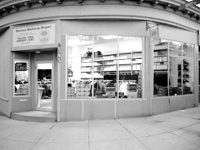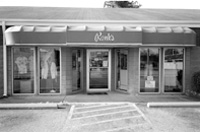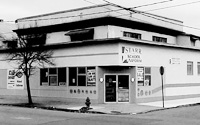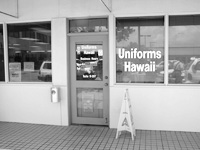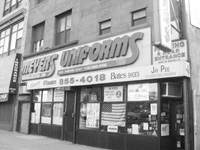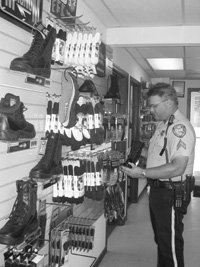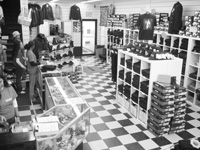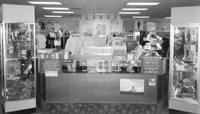|
By Bernadette Doran Wheres the opportunity for excitement in the uniform retail environment? Uniforms are something people have to buy, a required essential like toothpaste or underwear, and drudgery to shop for, right? Hardly. When Target thinks toothpaste and Victorias Secret thinks underwear, a fantasyland of sensory appeal, merchandising magic and design ingenuity beckon customers to spend, spend, spend and they do. Wherever people can buy something, theres an opportunity for them to buy something more, including the uniform retail store. Our customers arent any different from mainstream Americans shopping anywhere. We are evolving continuously, trying to find better ways to sell, says Jim Ronk, owner of Ronks Uniform Center, a 5,000-square-foot retail emporium. But the explosion of sensory media in American culture has created new pressures for retailers. Cell phones that make movies, iPods that play the soundtrack of our lives, and Blackberries that put the whole world of the Internet in our hand have raised the ante for getting the customers attention. America is now a very sophisticated graphic environment, and anything amateurish is ignored and dismissed. Plus, our harried, multi-tasking lives now give us so little time and so little joy. Can a retailer make shopping both pleasurable and efficient, thereby gaining a grateful customer for life? First Impressions When it comes to overall design, the retailer should try entering the store as a customer would the first time, suggests Maggie Ferrari, author of Retail Traffic. She suggests four key questions to help a retailer create the perfect store design: Is there something to invite the customer into the store? Is there something to promote curiosity? That first impression says a lot about who you are and what you have to sell, says Ferrari. If the store looks drab and boring, that perception reflects your image and the quality of your products and services. How do you want your customers to feel when they come into your store? Is your store high tech, warm and friendly, interactive? Make sure there are elements that support your message, whether its a color scheme throughout the store, large graphics or special displays that support key products. Is the traffic flow optimal? Customers should have plenty of room to move around and have easy access to the cash register. Any visuals or products drawing a lot of attention should be easily accessible, she says. What is the stores main objective? Is it impulse purchases, lingering customers, or education? Answering these questions will give the retailer a new perspective on how to make the store customer friendly, adds Ferrari. Would a revamp really pay? More than youd probably expect. After American Eagle Outfitter redesigned some prototype stores, their average store sales increased 46 percent overall in those locations, and sales per square foot increased 29 percent. The Wow Factor You have to always remember that youre creating an exciting moment for the customer, says Russ Sway, president of the Institute of Store Planners, quoted in Retail Traffic. When they walk into a store you want them to say wow to products that have already existed. One way to create that wow factor is by adding a compelling visual backdrop. For example, Mike MacGillivray, retail marketing director for Herman Goelitz Candy Co., says color and graphic elements were pivotal in designing the Jelly Belly Visitor Center, supporting their key product. Giant jelly beans are scattered all over the floor via vinyl graphics, and wall-size photos of actual factory production surround the customer. Thanks to new technology, royalty-free photos from online stock photo sources plus inexpensive printing from places like Office Depot or Kinkos now put high design within the affordable reach of even the smallest retailer. Larger-than-life adhesive vinyl graphics applied electrostatically to walls (wallpaper without glue), photomurals, fabric banners, counter cards and textured graphics are all exciting and affordable options. Different customers are going to be inspired by different visual cues, based on their profession and their personality, according to Jack Gniadecki, group creative director at Ambrosi, specialists in visual merchandising and retail marketing. Gniadecki has personally served such clients as Carson Pirie Scott, Sears and a number of small boutique retailers in downtown Chicago. Anything that appeals to their professionalism, respecting them and their position, will inspire confidence and help build sales. For example, policemen would be inspired by heroic photos visuals that are realistic, powerful, a situation they can see themselves in, Gniadecki says. On the other hand, for healthcare workers, their job is to be compassionate and take away your fears. They will respond to walls painted in soft color palettes that signal approachability. According to Barbara Jacobs writing in Retail Traffic on the psychological effect of color, that palette might include shades of blue (trust, integrity), green (nurturing) or yellow (cheerful, communicative). Comfortable, sophisticated neutrals and more subtle textures can be punctuated with strong hues and mixed materials for visual interest, she says. When using bright splashes of color, dont let the customers eyes get distracted. Rather, surround areas of bright color with areas of neutrality. Give the eyes specific focal points with direction toward the product, urges Ferrari. She also suggests including the stores basic color scheme in product, welcome and thank you signage. Entertainment & Solution Zones Todays challenge is to design a dramatic and gripping retail atmosphere, according to Jessica Marro writing in Retail Traffic. She says, Stores rich with entertainment keep shoppers on their toes and create a shopping experience that surprises, intrigues and allures. Some stores have a bigger built-in entertainment opportunity than others at Dicks Sporting Goods you can practice your swing, and Toys R Us offers free family photographs. But a customer can count on a free cup of coffee from most car repair shops, and many retailers offer play areas for kids. Any uniform retailer can do the same and more. However, the first definition of entertain, according to Websters, is engage, and that means inviting the customer to interact with as many products as possible. Apple Computer retail stores lead the way here. They feature Solution Zones in which Apple Computer products are grouped by customer interests, function or activity for example, everything you want and need to create digital photos, music or movies and an invitation to try it all out. For uniform retailers, the key to these kinds of product groupings is personal relevance, says Gniadecki, and he recommends cross merchandising as much as possible, either on a model or in display areas. Walking into a retail store that sells any kind of clothing and accessories is like walking into your closet. The question is how can I put an outfit together? What will help me look my best? People want to look as good or better as a professional than they do at other any time, he says. The Solutions Zone concept at uniform retailer Graves Inc. means a combination of the right accessories, and a personal approach to selecting them. People come in thinking about a particular item to buy for example, a white shirt, says owner Bill Graves. Now you suggest the tie, the belt. If youve sold them nothing but the shirt, you havent really sold them anything youve just filled the order. Selling means having them buy more than what they came in for. Just like big department stores, Ronk divides up his 5,000 square feet into mini-boutiques and posts signage to help customers self-select areas of interest. For example, we have two shoe departments light shoes for healthcare workers and food service personnel and blue goods for police, fire and security workers, says Graves. Clothing is divided similarly, with a 2,500 square foot area for white goods and two dressing rooms, another large area for police and fire uniforms, with two more dressing rooms to serve those customers. The dressing rooms are back to back, to facilitate spillover from one area to another for try-ons. This helps draw the customer in, says Ronk. They can scan the whole 5,000 square feet and head directly toward their main interest. Allowing the customer to see, touch and try on everything will seal the deal. Have as many products out there as possible, one of everything, says Nathan Mag of Mag & Son Clothing. People cannot visualize. They have to see, feel it, touch it. Ride the Trends Another way of increasing sales is identifying trends and then stocking merchandise to capitalize on them or selling existing products to an unexpected, new clientele. It works for Ronk. 20 years ago, we only had blue-collar workers come in here and buy nothing but uniforms, he says. Now, military-style battle dress uniforms are extremely popular with teens and young adults. Camouflage prints are a big fashion trend now, and we sell a lot of shirts, shorts and pants to teens. Similarly, people who dont work in the healthcare industry now come in to buy scrubs at Ronks Uniform Center just because theyre comfortable for lunging around at home, says Ronk. And a renewed respect for law enforcement after Sept. 11, 2001, keeps T-shirts that say Police moving off the shelves to people outside the ranks. Do You Want Fries with That? The usual figure is that 80 percent of a stores sales will come from 20 percent of its clientele. So if stores are to grow, it will be by figuring out how to get more out of existing customers, writes guru Paco Underhill in Why We Buy: The Science of Shopping. For uniform retailers, the big question then becomes: What else can you sell? What add-ons will the customer be naturally interested in, and therefore want to buy? Target is a great prototype for selling non-essential but desirable items, fun and appealing items, at checkout, says Gniadecki, adding that mark up and therefore profitability can be very high on these products. People are so time-pressed now, any store can sell almost any small items batteries, scotch tape, hair accessories, inspirational gift items, candy bars. People are going to buy these things. Why shouldnt you make these sales and save your customer the time to go someplace else? Customers at Graves Inc. do a lot of impulse buying at checkout. We sell a lot of small items like American flags and sunglasses, says Graves. Ronk discovered that all kinds of lights flashlights, reading lights, you name it do such big business, they now have their own department in his store. But if retailers offer add-ons, they have to make sure the customer knows what they are and actually wants them. Ronk started carrying rubber belts that go around the waist and help hold down shirttails. At first they were just offered in boxes on the selling floor, and they didnt move because customers didnt know what they were or how to use them. Once they were put up for display, they started to sell, says Ronk. Graves has had a few surprising product failures, including hand warmers and battery-operated heated socks. They just didnt go over. Nobody bought them, says Graves. Maybe add-ons are actually expand-ons. For example, what other kinds of uniforms could a uniform store carry? Weve been selling scouting uniforms for 30 years. That brings in the moms and dads who buy everything else too, says Ronk. Ronk also offers basic services to any customer. Ronks Uniform Center will alter any uniform and sew on patches but they also alter prom dresses, and any other garment a customer wants to bring in. Going to the Light Lighting should create a comfortable ambience for the customer while flattering the merchandise. But the right lighting is even more essential for the uniform retailer for other reasons. We learned that the hard way, says Mag. The fluorescent lights changed how the color of some uniforms were perceived. One customer thought he was buying a certain color, and when he got it outside, he saw that it was a different color altogether. I had to lower the cost of the order as a result. Mag ended up replacing all those fluorescent lights. I discussed it with light supplier, replaced them all with a special color light bulb, and got the correct kind of light that doesnt change the appearance of the item. Never Overlook the Basics No matter how much a retailer might jazz up the selling environment, the most seasoned store owners say customers will be turned off unless youve got the basics covered. The building should be clean and orderly. Changing rooms should be spotless. A bathroom should be available, and make sure its always clean, suggests Mag. Employees must have a professional appearance, and people who answer the phone must be knowledgeable, says Graves Most basic of all is simply to respond to what the customer wants as his or her needs change. Says Underhill in his book, The era of the visionary retailer or the manufacturer king is over. In the 21st century, the consumer will be king. Just as fashion now comes from the street up, the world of retail is about following shoppers where they are going.
|
|
| Above story first appeared in MADE TO MEASURE Magazine, Fall & Winter 2006 issue. All rights reserved. Photos appear by special permission. | |
| Halper Publishing Company 633 Skokie Blvd, #490 Northbrook, IL 60062 (847) 780-2900 Fax (224) 406-8850 [email protected] |
|





